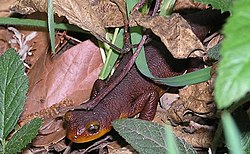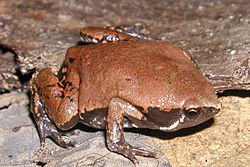Salamanders (Caudata)
Ambystomatidae



Order: Caudata. Family: Ambystomatidae
- Ambystoma annulatum Cope, 1886
- Ambystoma barbouri Kraus & Petranka, 1989
- Ambystoma bishopi Goin, 1950
- Ambystoma californiense Gray, 1853
- Ambystoma cingulatum Cope, 1868
- Ambystoma gracile (Baird, 1859)
- Ambystoma jeffersonianum (Green, 1827)
- Ambystoma laterale Hallowell, 1856
- Ambystoma mabeei Bishop, 1928
- Ambystoma macrodactylum Baird, 1850
- Ambystoma maculatum (Shaw, 1802)
- Ambystoma mavortium Baird, 1850
- Ambystoma opacum (Gravenhorst, 1807)
- Ambystoma talpoideum (Holbrook, 1838)
- Ambystoma texanum (Matthes, 1855)
- Ambystoma tigrinum (Green, 1825)
- Dicamptodon aterrimus (Cope, 1868)
- Dicamptodon copei Nussbaum, 1970
- Dicamptodon ensatus (Eschscholtz, 1833)
- Dicamptodon tenebrosus (Baird & Girard, 1852)
Amphiumidae

Order: Caudata. Family: Amphiumidae
- Amphiuma means Garden, 1821
- Amphiuma pholeter Neill, 1964
- Amphiuma tridactylum Cuvier, 1827
Cryptobranchidae

Order: Caudata. Family: Cryptobranchidae
- Cryptobranchus alleganiensis (Sonnini de Manoncourt & Latreille, 1801)
- Cryptobranchus bishopi Grobman, 1943
Plethodontidae

Order: Caudata. Family: Plethodontidae
- Batrachoseps altasierrae Jockusch, Martínez-Solano, Hansen, & Wake, 2012
- Batrachoseps attenuatus (Eschscholtz, 1833)
- Batrachoseps bramei Jockusch, Martínez-Solano, Hansen, & Wake, 2012
- Batrachoseps campi Marlow, Brode, & Wake, 1979
- Batrachoseps diabolicus Jockusch, Wake, & Yanev, 1998
- Batrachoseps gabrieli Wake, 1996
- Batrachoseps gavilanensis Jockusch, Yanev, & Wake, 2001
- Batrachoseps gregarius Jockusch, Wake, & Yanev, 1998
- Batrachoseps incognitus Jockusch, Yanev, & Wake, 2001
- Batrachoseps kawia Jockusch, Wake, & Yanev, 1998
- Batrachoseps luciae Jockusch, Yanev, & Wake, 2001
- Batrachoseps major Camp, 1915
- Batrachoseps minor Jockusch, Yanev, & Wake, 2001
- Batrachoseps nigriventris Cope, 1869
- Batrachoseps pacificus (Cope, 1865)
- Batrachoseps regius Jockusch, Wake, & Yanev, 1998
- Batrachoseps relictus Brame & Murray, 1968
- Batrachoseps robustus Wake, Yanev, & Hansen, 2002
- Batrachoseps simatus Brame & Murray, 1968
- Batrachoseps stebbinsi Brame & Murray, 1968
- Batrachoseps wrighti (Bishop, 1937)
- Eurycea aquatica Rose & Bush, 1963
- Eurycea arenicola (Stuart et al., 2020)
- Eurycea bislineata (Green, 1818)
- Eurycea chamberlaini Harrison & Guttman, 2003
- Eurycea chisholmensis Chippindale, Price, Wiens, & Hillis, 2000
- Eurycea cirrigera (Green, 1831)
- Eurycea guttolineata (Holbrook, 1838)
- Eurycea junaluska Sever, Dundee, & Sullivan, 1976
- Eurycea latitans Smith & Potter, 1946
- Eurycea longicauda (Green, 1818)
- Eurycea lucifuga Rafinesque, 1822
- Eurycea multiplicata (Cope, 1869)
- Eurycea nana Bishop, 1941
- Eurycea naufragia Chippindale, Price, Wiens, & Hillis, 2000
- Eurycea neotenes Bishop & Wright, 1937
- Eurycea pterophila Burger, Smith, & Potter, 1950
- Eurycea quadridigitata (Holbrook, 1842)
- Eurycea rathbuni (Stejneger, 1896)
- Eurycea robusta (Longley, 1978)
- Eurycea sosorum Chippindale, Price, & Hillis, 1993
- Eurycea spelaea (Stejneger, 1892)
- Eurycea subfluvicola Steffen, Irwin, Blair, & Bonett, 2014
- Eurycea tonkawae Chippindale, Price, Wiens, & Hillis, 2000
- Eurycea tridentifera Mitchell & Reddell, 1965
- Eurycea troglodytes Baker, 1957
- Eurycea tynerensis Moore & Hughes, 1939
- Eurycea wallacei (Carr, 1939)
- Eurycea waterlooensis Hillis, Chamberlain, Wilcox, & Chippindale, 2001
- Eurycea wilderae Dunn, 1920
- Gyrinophilus gulolineatus Brandon, 1965
- Gyrinophilus palleucus McCrady, 1954
- Gyrinophilus porphyriticus (Green, 1827)
- Gyrinophilus subterraneus Besharse & Holsinger, 1977
- Hemidactylium scutatum (Temminck, 1838)
- Pseudotriton diastictus Bishop, 1941
- Pseudotriton montanus Baird, 1850
- Pseudotriton ruber (Sonnini de Manoncourt & Latreille, 1801)
- Stereochilus marginatus (Hallowell, 1856)
- Urspelerpes brucei Camp, Peterman, Milanovich, Lamb, Maerz, & Wake, 2009
- Aneides aeneus (Cope & Packard, 1881)
- Aneides ferreus Cope, 1869
- Aneides flavipunctatus (Strauch, 1870)
- Aneides hardii (Taylor, 1941)
- Aneides iecanus (Cope, 1883)
- Aneides lugubris (Hallowell, 1849)
- Aneides niger Myers & Maslin, 1948
- Aneides vagrans Wake & Jackman, 1999
- Desmognathus abditus Anderson & Tilley, 2003
- Desmognathus aeneus Brown & Bishop, 1947
- Desmognathus apalachicolae Means & Karlin, 1989
- Desmognathus aureatus (Martof, 1956)
- Desmognathus auriculatus (Holbrook, 1838)
- Desmognathus brimleyorum Stejneger, 1895
- Desmognathus carolinensis Dunn, 1916
- Desmognathus conanti Rossman, 1958
- Desmognathus folkertsi Camp, Tilley, Austin, & Marshall, 2002
- Desmognathus fuscus (Rafinesque, 1820)
- Desmognathus imitator Dunn, 1927
- Desmognathus marmoratus (Moore, 1899)
- Desmognathus melanius (Martof, 1956)
- Desmognathus monticola Dunn, 1916
- Desmognathus ochrophaeus Cope, 1859
- Desmognathus ocoee Nicholls, 1949
- Desmognathus orestes Tilley & Mahoney, 1996
- Desmognathus organi Crespi, Browne, & Rissler, 2010
- Desmognathus planiceps Newman, 1955
- Desmognathus quadramaculatus (Holbrook, 1840)
- Desmognathus santeetlah Tilley, 1981
- Desmognathus welteri Barbour, 1950
- Desmognathus wrighti King, 1936
- Ensatina eschscholtzii Gray, 1850
- Hydromantes brunus Gorman, 1954
- Hydromantes platycephalus (Camp, 1916)
- Hydromantes shastae Gorman & Camp, 1953
- Phaeognathus hubrichti Highton, 1961
- Plethodon ainsworthi Lazell, 1998
- Plethodon albagula Grobman, 1944
- Plethodon amplus Highton & Peabody, 2000
- Plethodon angusticlavius Grobman, 1944
- Plethodon asupak Mead, Clayton, Nauman, Olson, & Pfrender, 2005
- Plethodon aureolus Highton, 1984
- Plethodon caddoensis Pope & Pope, 1951
- Plethodon chattahoochee Highton, 1989
- Plethodon cheoah Highton & Peabody, 2000
- Plethodon chlorobryonis Mittleman, 1951
- Plethodon cinereus (Green, 1818)
- Plethodon cylindraceus (Harlan, 1825)
- Plethodon dorsalis Cope, 1889
- Plethodon dunni Bishop, 1934
- Plethodon electromorphus Highton, 1999
- Plethodon elongatus Van Denburgh, 1916
- Plethodon fourchensis Duncan & Highton, 1979
- Plethodon glutinosus (Green, 1818)
- Plethodon grobmani Allen & Neill, 1949
- Plethodon hoffmani Highton, 1972
- Plethodon hubrichti Thurow, 1957
- Plethodon idahoensis Slater & Slipp, 1940
- Plethodon jordani Blatchley, 1901
- Plethodon kentucki Mittleman, 1951
- Plethodon kiamichi Highton, 1989
- Plethodon kisatchie Highton, 1989
- Plethodon larselli Burns, 1954
- Plethodon meridianus Highton & Peabody, 2000
- Plethodon metcalfi Brimley, 1912
- Plethodon mississippi Highton, 1989
- Plethodon montanus Highton & Peabody, 2000
- Plethodon neomexicanus Stebbins & Riemer, 1950
- Plethodon nettingi Green, 1938
- Plethodon ocmulgee Highton, 1989
- Plethodon ouachitae Dunn & Heinze, 1933
- Plethodon petraeus Wynn, Highton, & Jacobs, 1988
- Plethodon punctatus Highton, 1972
- Plethodon richmondi Netting & Mittleman, 1938
- Plethodon savannah Highton, 1989
- Plethodon sequoyah Highton, 1989
- Plethodon serratus Grobman, 1944
- Plethodon shenandoah Highton & Worthington, 1967
- Plethodon sherando Highton, 2004
- Plethodon shermani Stejneger, 1906
- Plethodon stormi Highton & Brame, 1965
- Plethodon teyahalee Hairston, 1950
- Plethodon vandykei Van Denburgh, 1906
- Plethodon variolatus (Gilliams, 1818)
- Plethodon vehiculum (Cooper, 1860)
- Plethodon ventralis Highton, 1997
- Plethodon virginia Highton, 1999
- Plethodon websteri Highton, 1979
- Plethodon wehrlei Fowler & Dunn, 1917
- Plethodon welleri Walker, 1931
- Plethodon yonahlossee Dunn, 1917
Proteidae
Order: Caudata. Family: Proteidae
- Necturus alabamensis Viosca, 1937
- Necturus beyeri Viosca, 1937
- Necturus lewisi Brimley, 1924
- Necturus louisianensis Viosca, 1938
- Necturus maculosus (Rafinesque, 1818)
- Necturus punctatus (Gibbes, 1850)
Rhyacotritonidae
Order: Caudata. Family: Rhyacotritonidae
- Rhyacotriton cascadae Good & Wake, 1992
- Rhyacotriton kezeri Good & Wake, 1992
- Rhyacotriton olympicus (Gaige, 1917)
- Rhyacotriton variegatus Stebbins & Lowe, 1951
Salamandridae
Order: Caudata. Family: Salamandridae

- Notophthalmus meridionalis (Cope, 1880)
- Notophthalmus perstriatus (Bishop, 1941)
- Notophthalmus viridescens (Rafinesque, 1820)
- Taricha granulosa (Skilton, 1849)
- Taricha rivularis (Twitty, 1935)
- Taricha sierrae (Twitty, 1942)
- Taricha torosa (Rathke, 1833)
Sirenidae
Order: Caudata. Family: Sirenidae
- Pseudobranchus axanthus Netting & Goin, 1942
- Pseudobranchus striatus (LeConte, 1824)
- Siren intermedia Barnes, 1826
- Siren lacertina Österdam, 1766








